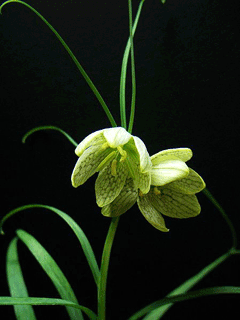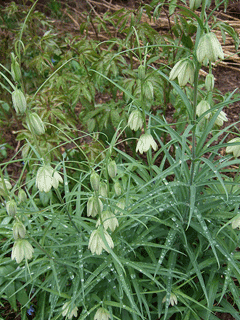 |
|
http://www.flickr.com/people/28481088@N00 |
 |
| http://commons.wikimedia.org/wiki/User:Jdsteakley |
Translate this page:
Summary
Physical Characteristics

 Fritillaria thunbergii is a BULB growing to 0.6 m (2ft).
Fritillaria thunbergii is a BULB growing to 0.6 m (2ft).
See above for USDA hardiness. It is hardy to UK zone 8. It is in flower from March to May. The species is hermaphrodite (has both male and female organs) and is pollinated by Insects.
Suitable for: light (sandy) and medium (loamy) soils and prefers well-drained soil. Suitable pH: mildly acid, neutral and basic (mildly alkaline) soils. It can grow in semi-shade (light woodland) or no shade. It prefers moist soil.
UK Hardiness Map
US Hardiness Map
Synonyms
F. collicola. Hance. F. verticillata thunbergii.
Plant Habitats
Woodland Garden Sunny Edge; Dappled Shade; Shady Edge;
Edible Uses
Edible Parts: Leaves Root
Edible Uses:
Bulb - fried or candied[177]. The bulb is up to 3cm in diameter[266]. Young plants and buds - cooked[177].
References More on Edible Uses
Medicinal Uses
Plants For A Future can not take any responsibility for any adverse effects from the use of plants. Always seek advice from a professional before using a plant medicinally.
Antitussive Expectorant Febrifuge
The bulbs are antidote, antitussive, astringent, expectorant, galactogogue and purgative[147, 174, 176, 218]. They contain fritimine which diminishes excitability of respiratory centres, paralyses voluntary movement and counters effects of opium[61]. The bulbs are thought to act specifically on tumours and swellings of the throat, neck and chest, and they are taken in the treatment of thyroid gland nodules, scrofula, abscesses and boils and breast cancer[254]. The bulb is used internally in the treatment of coughs, bronchitis, pneumonia, feverish illnesses, abscesses etc[238]. The bulbs also have a folk history of use against cancer of the breast and lungs in China[218, 238]. This remedy should only be used under the supervision of a qualified practitioner, excessive doses can cause breathing difficulties and heart failure[238]. The bulbs are harvested in the winter whilst they are dormant and are dried for later use[238].
References More on Medicinal Uses
The Bookshop: Edible Plant Books
Our Latest books on Perennial Plants For Food Forests and Permaculture Gardens in paperback or digital formats.

Edible Tropical Plants
Food Forest Plants for Hotter Conditions: 250+ Plants For Tropical Food Forests & Permaculture Gardens.
More

Edible Temperate Plants
Plants for Your Food Forest: 500 Plants for Temperate Food Forests & Permaculture Gardens.
More

More Books
PFAF have eight books available in paperback and digital formats. Browse the shop for more information.
Shop Now
Other Uses
References More on Other Uses
Cultivation details
Best grown in a moist peaty soil in the open garden[90]. Easily grown in a moderately fertile soil in sun or semi-shade[200]. Succeeds in drier soils and is drought tolerant when established[190]. The dormant bulbs are fairly hardy and will withstand soil temperatures down to at least -5°c[214]. The scaly bulbs are best planted on their sides or surrounded in sand to prevent water collecting in their hollow crowns[238]. This species is cultivated as a medicinal plant in Europe and Asia[163]. Plants take 3 - 5 years to flower from seed.
References Carbon Farming Information and Carbon Sequestration Information
Temperature Converter
Type a value in the Celsius field to convert the value to Fahrenheit:
Fahrenheit:
The PFAF Bookshop
Plants For A Future have a number of books available in paperback and digital form. Book titles include Edible Plants, Edible Perennials, Edible Trees,Edible Shrubs, Woodland Gardening, and Temperate Food Forest Plants. Our new book is Food Forest Plants For Hotter Conditions (Tropical and Sub-Tropical).
Shop Now
Plant Propagation
Seed - best sown as soon as ripe in a cold frame, it should germinate in the spring[1]. Protect from frost[134]. Stored seed should be sown as soon as possible and can take a year or more to germinate[134]. Sow the seed quite thinly to avoid the need to prick out the seedlings. Once they have germinated, give them an occasional liquid feed to ensure that they do not suffer mineral deficiency. Once they die down at the end of their second growing season, divide up the small bulbs, planting 2 - 3 to an 8cm deep pot. Grow them on for at least another year in light shade in the greenhouse before planting them out whilst dormant. Division of offsets in August[1]. The larger bulbs can be planted out direct into their permanent positions, but it is best to pot up the smaller bulbs and grow them on in a cold frame for a year before planting them out in the autumn. Bulb scales[163].
Other Names
If available other names are mentioned here
Native Range
TEMPERATE ASIA: China (Anhui Sheng, Jiangsu Sheng (south), Zhejiang Sheng (north))
Weed Potential
Right plant wrong place. We are currently updating this section.
Please note that a plant may be invasive in one area but may not in your area so it's worth checking.
Conservation Status
IUCN Red List of Threatened Plants Status :

Growth: S = slow M = medium F = fast. Soil: L = light (sandy) M = medium H = heavy (clay). pH: A = acid N = neutral B = basic (alkaline). Shade: F = full shade S = semi-shade N = no shade. Moisture: D = dry M = Moist We = wet Wa = water.
Now available:
Food Forest Plants for Mediterranean Conditions
350+ Perennial Plants For Mediterranean and Drier Food Forests and Permaculture Gardens.
[Paperback and eBook]
This is the third in Plants For A Future's series of plant guides for food forests tailored to
specific climate zones. Following volumes on temperate and tropical ecosystems, this book focuses
on species suited to Mediterranean conditions—regions with hot, dry summers and cool, wet winters,
often facing the added challenge of climate change.
Read More
Expert comment
Author
Miq.
Botanical References
200266
Links / References
For a list of references used on this page please go here
Readers comment
| Add a comment |
|
If you have important information about this plant that may help other users please add a comment or link below. Only comments or links that are felt to be directly relevant to a plant will be included. If you think a comment/link or information contained on this page is inaccurate or misleading we would welcome your feedback at [email protected]. If you have questions about a plant please use the Forum on this website as we do not have the resources to answer questions ourselves.
* Please note: the comments by website users are not necessarily those held by PFAF and may give misleading or inaccurate information.
To leave a comment please Register or login here All comments need to be approved so will not appear immediately.
|
Subject : Fritillaria thunbergii
|
|
|
|